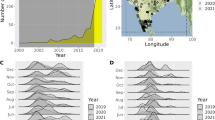Summary
A simple passive diffusion model is used to analyze the local within-habitat dispersal of twelve species of herbivorous insects. The data comprise field mark-recapture studies in relatively homogeneous habitats. For eight of the species, the cumulative frequency distributions of dispersal distances are consistent with a model of movement by passive diffusion. The observed departures from passive diffusion indicate the directions in which we need to modify our mathematical descriptions of movement if we are to develop realistic models of population dynamics and dispersal. The analyses also synthesize in a standard way the relative dispersal rates of several ecologically similar species. The variation both within and between species in diffusion coefficients is striking-certainly sufficient to generate significant consequences for population dynamics and interactions.
Similar content being viewed by others
References
Aikman D, Hewitt G (1972) An experimental investigation of the rate and form of dispersal in grasshoppers. J Appl Ecol 9:807–817
Broadbent SR, Kendall DG (1953) The random walk of Trichostrongylus retortaeformis. Biometrics 9:460–466
Cameron EA, McNamus ML, Mason CJ (1979) Dispersal and its impact on the population dynamics of the gypsy moth in the USA. Bull Soc Entom Suisse 52:169–179
Crumpacker DW, Williams JS (1973) Density, dispersion, and population structure in Drosophila pseudoobscura. Ecol Mon 43:498–538
Dempster J (1957) The population dynamics of the Moroccan locust in Cyprus. Anti-Locust Bull 27:1–59
Dobzhansky T, Powell JR, Taylor CE, Andregg M (1979) Ecological variables affecting the dispersal behavior of Drosophila pseudoobscura and its relatives. Amer Nat 114:325–334
Dobzhansky T, Wright S (1943) Genetics of natural populations. X. Dispersion rates in Drosophila pseudoobscura. Genetics 28:304–340
Eguagie WE (1974) An analysis of movement of adult Tingis ampliata (Heteroptera: Tingidae) in a natural habitat. J An Ecol 43:521–535
Elton C (1949) Population interspersion: an essay on animal community patterns. J Ecol 37:1–23
Freeman GH (1977) A model relating numbers of dispersing insects to distance and time. J Appl Ecol 14:477–487
Gurney WSC, Niset RM (1976) A note on nonlinear population transport. J Theor Biol 56:249–251
Iwao S, Machida A (1963) A marking-and recapture analysis of the adult population of a phytophagous lady-beetle, Epilachna sparsa orientalis. Res Pop Ecol 5:107–116
Johnston J, Heed WB (1975) Dispersal of Drosophila: the effect of baiting on the bahvior and distribution of natural populations. Am Nat 109:207–216
Joyce RJV (1976) Insect flight in relation to problems of pest control. in Rainey RC, ed., Insect Flight, RES Symp 7, Blackwell, Oxford
Kareiva P (1981) Non-migratory movement and the distribution of herbivorous insects: experiments with plant spacing and the application of diffusion models to mark-recapture data. Dissertation. Cornell Univ, Ithaca NY, USA
Kareiva P (1982) Experimental and mathematical analysis of herbivore movement: quantifying the influence of plant spacing and quality on foraging discrimination. Ecol Mon 52:261–282
Kiritani K, Hokyo N, Iwao S (1966) Population behavior of the southern green stinkbug, Nezara viridula, with special reference to the developmental stages of early-plnted paddy. Res Pop Ecol 8:133–146
Lamb KP, Hassan E, Scotter DR (1971) Dispersal of scandium-46-labeled Partorhytes weevils in Papuan cacao plantations. Ecol 52:178–182
Levin SA (1974) Dispersion and population interactions. Am Nat 108:207–228
Levin SA (1981) The role of theoretical ecology in the description and understanding of populations in hetrogeneous environments. Amer Zool 21:865–875
Long GE (1977) Spatial dispersion in a biological control model for larch casebearer (Coleophora laricella). Env Ent 6:843–851
Ludwig D, Aronson DG, Weinberger HF (1979) Spatial patterning of the spruce budworm. J Math Biol 8:217–258
McEvoy PB (1977) Adaptive significance of clumped dispersion in treehopper, Publilia concava (Homoptera: Membracidae). Dissertation. Cornell University, Ithaca NA, USA
McMurtrie R (1978) Persistence and stability of single-species and prey-predator systems in spatially heterogeneous environments. Math Biosc 39:11–51
Namba T (1980) Density-dependent dispersal and spatial distribution of a population. J Theor Bil 86:351–363
Okubo A (1980) Diffusion and ecological problems: mathematical models. Springer-Verlag, New York NY, USA
Pielou EC (1977) Mathematical Ecology. Wiley, New York NY, USA
Rausher M (1979) Coevolution in a simple plant-herbivore system. Dissertation. Cornell University, Ithaca NY, USA
Richardson RH (1970) Models and analyses of dispersal patterns. in Kojima ed, Mathematical Topics in Population Genetics. Springer-Verlag, New York NY, USA
Shigesada N (1980) Spatial distribution of dispersing animals. J Math Biol 9:85–96
Shigesada N, Kawasaki K, Teramoto E (1979) Spatial segregation of interacting species. J Theor Biol 79:83–99
Skellam LG (1951) Random dispersal in theoretical populations. Biometrika 38:196–218
Smith RW, Whittaker JB (1980) Factors affecting Gastrophysa viridula populations (Coleoptera: Chrysomelidae) in different habitats. J Anim Ecol 49:537–548
Sokal RR, Rohlf FJ (1969) Biometry. WH Freeman, San Francisco CA, USA
Taylor RAJ (1980) A family of regression equations describing the density distribution of dispersing organisms. Nature 286:53–55
Watanabe M (1978) Adult movements and resident ratios of the black-veined white, Aporia crataeyi, in a hilly region. Jap J Ecol 28:101–109
Wolfenbarger DO (1975) Factors affecting dispersal distances of small organisms. Exposition Press, Hicksville NY, USA
Author information
Authors and Affiliations
Rights and permissions
About this article
Cite this article
Kareiva, P.M. Local movement in herbivorous insects: applying a passive diffusion model to mark-recapture field experiments. Oecologia 57, 322–327 (1983). https://doi.org/10.1007/BF00377175
Received:
Issue Date:
DOI: https://doi.org/10.1007/BF00377175




